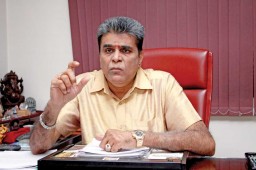
That the Tirupur industry is not completely ‘healthy’ is not news, with some confirmed and some unconfirmed news of the industry making rounds for some time now, but what is worrying is the magnitude of the losses and the repercussions… No one doubts that the biggest names in the region are in a bad shape and many even say that some are looking for potential buyers to exit the business. With reports getting murkier, Apparel Online met Dr A Sakthivel, President, TEA and current AEPC Chairman, who was more than keen to give a ‘fair’ picture of what is happening in the knit city, which he has nurtured for many years.
At the onset, Sakthivel honestly admitted that all was not well with the industry, though he pointed out that the situation was being blown out of proportion by miscreants who were trying to malign the growth story of Tirupur. “Tirupur from being one of the fastest growing clusters in the last decade, registering at an average 10-12 per cent growth year-on-year, is now stagnating, as over the last three years the growth has remained at around Rs. 13,000 crore. While it should have reached about Rs. 17,000 crore in FY 2011-12, this stagnation brought on by a combination of global and local issues have shaken the foundation of the industry,” argues Sakthivel.
Though he accepted that the industry is not seeing growth for two years now, he vehemently denies that some of the big companies are on the verge of closure. “When order sizes diminish, buyers tend to pull out from the smaller vendors and consolidate their orders with the bigger players, so the bigger players are still getting orders. What has happened is that with the decrease in business, profitability too has dropped so exporters now survive on packing credits from the banks, because of which loans have been piling up,” justifies Sakthivel.
[bleft]Tirupur from being one of the fastest growing clusters in the last decade, registering at an average 10-12 per cent growth year-on-year, is now stagnating as over the last three years the growth has remained at around Rs. 13,000 crore.[/bleft]
However, he agrees to the news that most companies in their enthusiasm to grow made huge investments and are now finding it difficult to repay the interest on loans. This acute financial burden has compelled the industry to seek Government intervention for loan restructuring. “If we see the applications for restricting it is mostly from those companies that went in for backward integration, as they faced the most problems with yarn prices fluctuating erratically making it difficult to take business decisions,” avers Sakthivel.
He rubbishes whispers that his own company is selling its garmenting units, claiming that they recently sold one building, which was not even a manufacturing unit as a pure financial decision, but which seems to have sparked off speculations. “We are wedded to this industry and there is no thought of pulling out though we may be investing in other areas also,” says Sakthivel.
He is saddened that people are spreading false news regarding companies like Eastman, SP Apparels, Prem Group, SCM all of whom are restructuring their business. While Eastman is consolidating and even looking at fresh investments once the FTA with Europe comes through, SP Apparels which has invested in the Crocodile brand and Prem Group which has invested in Switcher brand are slowly picking up after the initial hick-ups of managing domestic retail. SCM had put too much emphasis on the spinning business, but now the operations are more balanced. When questioned about news of a suicide by the owner of Best Apparels, he denies that it was because of business problems. “A hasty irrational act by a mill owner, has cast a negative reflection on the industry, which is very unfortunate,” avers Sakthivel.
In the meanwhile, the Tirupur industry is advocating the conspiracy theory saying that many of the negative reports are propagation by the north, which benefited from the crisis in Tirupur… How far this is true is difficult to say, but it cannot be denied that a good chunk of business from the region has shifted north over the last year as buyers were unsure of quality and delivery schedules… Indeed the current turmoil has made the competition for business among the various manufacturing centres very fierce.
Criticizing the dependency on traditional markets, Sakthivel was mused that exporters never took initiatives to seek new markets putting all their energies on servicing the US and European buyers. “With around 49 per cent of our products going to Europe, the debt crises in the euro zone was bound to create repercussions in India, and Tirupur is no different,” says Sakthivel. He goes on to add that one of his first priorities as soon as he took over as Chairman AEPC was to explore new market options…, now there are BSM’s already happening and planned for Russia, South America, Scandinavian countries, Israel and Japan. “Exporters are realizing the importance of such efforts and for the first time, out of the 145 exhibitors who went to Japan, 25 were from Tirupur,” informs Sakthivel. Another first is a BSM in New York in January 2013, as most of the US marketing efforts have been at the Magic. “Tirupur exporters were never wanting for orders, but now they are making effort to participate in fairs and promote business,” he adds.
The effort of the AEPC is to change the current market ratio for Indian exports of 49 per cent Europe, 26 per cent US and 25 per cent other countries to a more balanced 40 per cent Europe, 25 per cent US and 35 per cent other countries. “I can boldly say that over the last two months the US is picking up and the worst is over, we now need to hold on and learn from the experience to build a stronger market base,” says Sakthivel.
What also needs to be done is to widen the product basket. “Tirupur has become limited in its offerings and has unwittingly come into direct competition to Bangladesh in knits, which is an unfair comparison with the labour cost and duty-free advantage that they enjoy. Now we are looking to increase the products using blended yarn, so we can work throughout the year and also explore sportswear with performance properties and lingerie as the next big product category out of Tirupur,” says Sakthivel. Already over 100 Sri Lankan expats are working in Tirupur to improve systems and build factories for these niche products.
Not wanting to dwell on past issues, Sakthivel says that the local issues that impacted in industry like energy shortage, yarn price uncertainties and ETP crisis is almost over. With the Tamil Nadu Government taking constructive measures to speed up work on three thermal projects, Vallur, Mettur and North Chennai, the energy shortage is expected to be under control. In the meanwhile, 260 CTPs and 40 individual dyeing units are back in action in Tirupur and the industry hopes that this will bring buyer confidence back.
Thankfully cotton prices too have been less volatile in the past four months. “It has been a very difficult two years for Tirupur, but the ‘never say die’ attitude of the industry has come in handy and though most capacities in factories are underutilized today, I am positive that we will bounce back strongly very soon,” he concludes.






